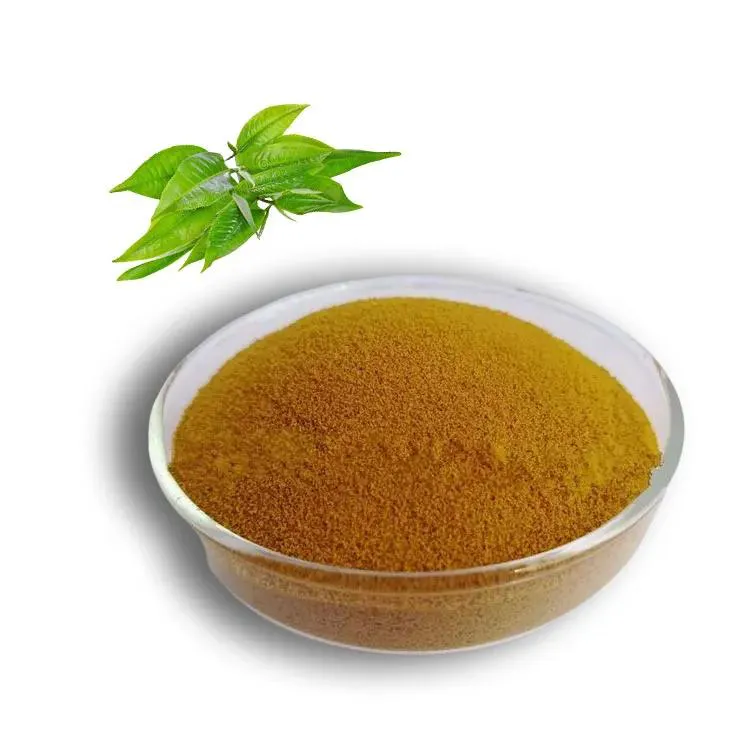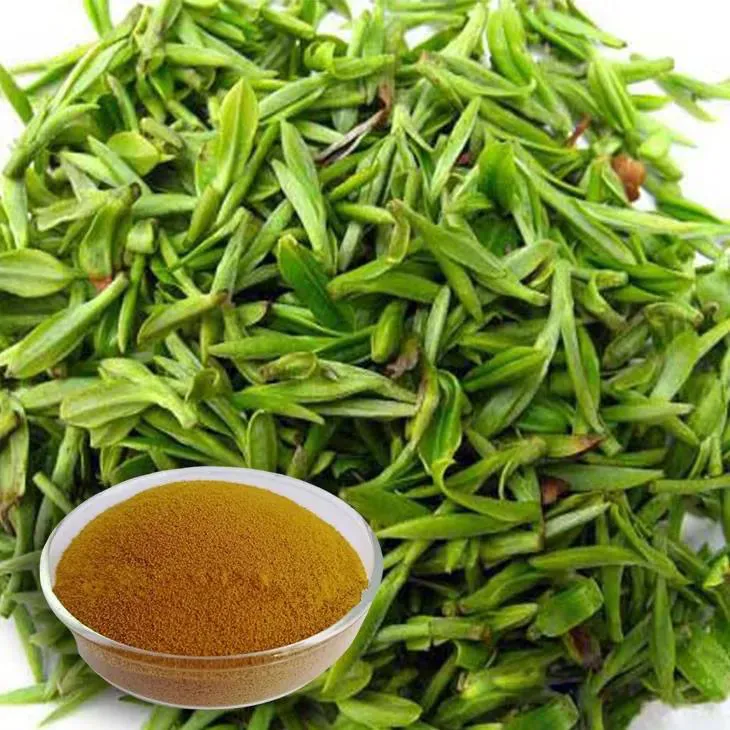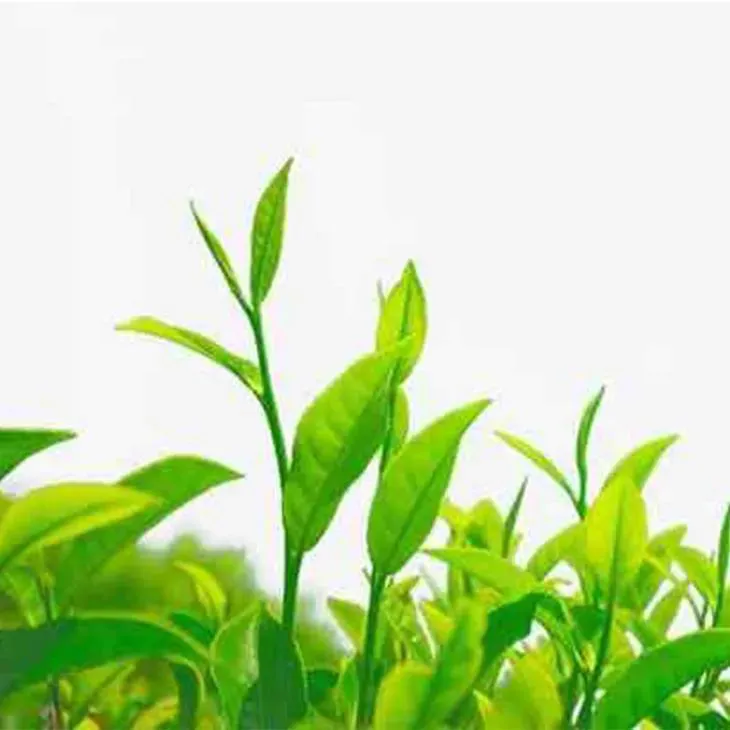- 0086-571-85302990
- sales@greenskybio.com
How to Extract Green Tea Extract from Plants.
2024-11-29

1. Introduction
Green tea has been renowned for its numerous health benefits and unique flavor profile for centuries. The extraction of Green Tea Extract from plants, specifically from Camellia sinensis, is a process that has gained significant importance in various industries such as the pharmaceutical, cosmetic, and food industries. This article will explore in detail the different methods of extracting Green Tea Extract, the factors to consider during the extraction process, and the applications of the obtained extract.

2. The Plant Source: Camellia sinensis
2.1 Characteristics of Camellia sinensis
Camellia sinensis is a species of evergreen shrub or small tree native to Asia. It has distinctively shiny, dark - green leaves that are lanceolate in shape. The plant thrives in tropical and subtropical climates, preferring well - drained soil and partial shade. Different varieties of Camellia sinensis, such as var. sinensis and var. assamica, have slightly different chemical compositions, which can influence the quality and characteristics of the Green Tea Extract obtained.
2.2 Cultivation and Harvesting
Cultivation of Camellia sinensis requires careful attention to several factors. Adequate watering, fertilization, and pest control are essential for healthy plant growth. The plants are usually harvested by hand - plucking the young leaves and buds. Harvesting at the right time is crucial as it affects the quality of the green tea. For example, the first flush (the first harvest of the season) is often considered to produce the highest - quality leaves, rich in bioactive compounds.

3. Extraction Methods
3.1 Steam Distillation
- Preparation of Plant Material: The fresh or dried leaves of Camellia sinensis are first prepared. They should be clean and free from any contaminants. The leaves are usually crushed or ground to increase the surface area available for extraction.
- Steam Generation: A steam generator is used to produce steam. The steam is then passed through the plant material. As the steam comes into contact with the green tea leaves, it causes the volatile compounds in the leaves to vaporize.
- Condensation: The vaporized compounds, along with the steam, are then passed through a condenser. The condenser cools the vapor, causing it to return to a liquid state. This liquid contains the green tea extract along with water.
- Separation: The resulting liquid is then separated to obtain the green tea extract. This can be done through methods such as decantation or using a separating funnel. The advantage of steam distillation is that it is a relatively simple and traditional method. However, it may not be very efficient in extracting all the non - volatile but valuable compounds present in green tea.
3.2 Ultrasound - Assisted Extraction
- Equipment Setup: Specialized ultrasound - generating equipment is required. The green tea leaves are placed in a suitable solvent, such as ethanol or water. The choice of solvent depends on the desired components to be extracted.
- Ultrasound Application: Ultrasound waves are then applied to the mixture. The high - frequency sound waves create cavitation bubbles in the solvent. These bubbles collapse violently, creating local high - pressure and high - temperature zones. This mechanical and physical effect helps in breaking the cell walls of the green tea leaves, facilitating the release of the internal components into the solvent.
- Extraction Time and Conditions: The extraction time, frequency of the ultrasound, and temperature need to be carefully controlled. Longer extraction times may increase the yield, but may also lead to the degradation of some sensitive compounds. Optimal conditions usually need to be determined through experimentation.
- Separation and Purification: After the extraction process, the mixture is filtered to remove the solid plant material. The resulting solution may then be further purified through methods such as evaporation to remove the solvent and obtain a more concentrated green tea extract. Ultrasound - assisted extraction is known for its relatively high efficiency and shorter extraction times compared to some traditional methods.
3.3 Solvent Extraction
- Solvent Selection: A suitable solvent is chosen. Common solvents used for green tea extraction include ethanol, methanol, and water. Ethanol is often preferred as it can dissolve a wide range of compounds present in green tea, including polyphenols, flavonoids, and caffeine. The polarity of the solvent plays an important role in determining which components will be extracted.
- Mixing and Extraction: The ground or powdered green tea leaves are mixed with the solvent in a suitable container. This can be done through agitation, such as shaking or stirring. The extraction process may take several hours to days, depending on the solvent, temperature, and the ratio of plant material to solvent.
- Filtration and Concentration: After the extraction, the mixture is filtered to separate the liquid extract from the solid residue. The filtrate can then be concentrated to obtain a more potent green tea extract. This can be achieved through methods such as rotary evaporation, which reduces the volume of the solvent under reduced pressure.

4. Factors Affecting the Extraction
4.1 Temperature
Temperature plays a crucial role in the extraction process. Different extraction methods may have different optimal temperature ranges. For example, in solvent extraction, a higher temperature may increase the solubility of the compounds in the solvent, but it may also cause the degradation of some heat - sensitive components. In steam distillation, the temperature of the steam needs to be sufficient to vaporize the volatile compounds effectively.
4.2 Solvent - to - Plant Ratio
The ratio of the solvent used to the amount of plant material is an important factor. A higher solvent - to - plant ratio may generally lead to a higher extraction yield, as there is more solvent available to dissolve the compounds from the green tea leaves. However, this also needs to be balanced with cost - effectiveness and the subsequent purification steps.
4.3 Particle Size of Plant Material
The size of the green tea leaves or plant material affects the extraction efficiency. Finer particles have a larger surface area, which allows for better contact with the solvent or steam during the extraction process. However, overly fine particles may also cause problems such as clogging in filtration steps.
4.4 Extraction Time
The length of the extraction process is another factor to consider. Longer extraction times may increase the yield of the green tea extract, but may also lead to the extraction of unwanted compounds or the degradation of valuable ones. Therefore, the extraction time needs to be optimized for each extraction method.
5. Applications of Green Tea Extract
5.1 In the Pharmaceutical Industry
Green tea extract is rich in polyphenols, such as epigallocatechin - 3 - gallate (EGCG), which have been shown to have antioxidant, anti - inflammatory, and anti - cancer properties. In the pharmaceutical industry, green tea extract is being studied for its potential in treating various diseases, including cancer, cardiovascular diseases, and neurodegenerative disorders. It may be used as an ingredient in dietary supplements or as a basis for the development of new drugs.
5.2 In the Food Industry
Green tea extract is used as a natural flavoring agent in the food industry, providing a unique and refreshing taste. It is also added to some foods for its antioxidant properties, which can help in extending the shelf - life of products. For example, it can be added to baked goods, beverages, and dairy products.
5.3 In the Cosmetic Industry
The antioxidant and anti - inflammatory properties of green tea extract make it a valuable ingredient in the cosmetic industry. It is used in skincare products such as creams, lotions, and serums to help protect the skin from damage caused by free radicals, reduce inflammation, and improve skin complexion.
6. Conclusion
Extracting green tea extract from Camellia sinensis is a complex process that involves careful consideration of the plant source, extraction methods, and various factors that affect the extraction. The different extraction methods, such as steam distillation, ultrasound - assisted extraction, and solvent extraction, each have their own advantages and limitations. The obtained green tea extract has a wide range of applications in the pharmaceutical, food, and cosmetic industries. Continued research in this area is likely to lead to improved extraction techniques and new applications for this valuable natural extract.
FAQ:
Question 1: Why is Camellia sinensis the typical plant source for green tea extract?
Camellia sinensis is the typical plant source for green tea extract because it contains the unique compounds that are characteristic of green tea. These include catechins, polyphenols, and other bioactive substances. The plant has evolved to produce these compounds, which are responsible for the health benefits and flavor profile associated with green tea.
Question 2: What are the advantages of steam distillation in extracting green tea extract?
Steam distillation has several advantages in extracting green tea extract. It is a relatively gentle method that can preserve the integrity of some of the more delicate compounds in green tea. It can effectively separate volatile components, which may contribute to the aroma and certain therapeutic properties of the extract. Also, it is a well - established and traditional method, often resulting in a relatively pure extract.
Question 3: How does ultrasound - assisted extraction work for green tea?
Ultrasound - assisted extraction for green tea works by using ultrasonic waves. These waves create cavitation bubbles in the extraction solvent. When these bubbles collapse, they generate intense local forces and high - temperature regions for a very short time. This helps to break the cell walls of the green tea plant material more efficiently, allowing the release of the desired compounds into the solvent, thus enhancing the extraction process.
Question 4: What are the main components extracted from green tea plants?
The main components extracted from green tea plants are catechins, which are a type of polyphenol. These include epigallocatechin gallate (EGCG), which is one of the most abundant and well - studied catechins. Other components include caffeine, flavonoids, and amino acids like L - theanine. These components contribute to the antioxidant, anti - inflammatory, and other health - promoting properties of green tea extract.
Question 5: Are there any safety concerns when extracting green tea extract?
When extracting green tea extract, there can be some safety concerns. For example, if improper solvents are used, there may be residues left in the extract that could be harmful. Also, over - extraction or the use of high - intensity extraction methods inappropriately may damage some of the compounds, potentially leading to the formation of unwanted by - products. Additionally, in industrial - scale extraction, proper handling of equipment and chemicals is necessary to ensure the safety of workers.
Related literature
- Green Tea Extract: Chemistry, Antioxidant Properties and Applications"
- "Advances in Green Tea Extraction Technologies"
- "The Bioactive Compounds of Camellia sinensis and Their Extraction for Functional Foods"
- ▶ Hesperidin
- ▶ citrus bioflavonoids
- ▶ plant extract
- ▶ lycopene
- ▶ Diosmin
- ▶ Grape seed extract
- ▶ Sea buckthorn Juice Powder
- ▶ Beetroot powder
- ▶ Hops Extract
- ▶ Artichoke Extract
- ▶ Reishi mushroom extract
- ▶ Astaxanthin
- ▶ Green Tea Extract
- ▶ Curcumin Extract
- ▶ Horse Chestnut Extract
- ▶ Other Problems
- ▶ Boswellia Serrata Extract
- ▶ Resveratrol Extract
- ▶ Marigold Extract
- ▶ Grape Leaf Extract
- ▶ blog3
- ▶ blog4
-
Supplier of Hedyotis diffusa extract.
2024-11-29
-
Standard - process stevia extract.
2024-11-29
-
The Best Apple Cider Vinegar Powder in 2024.
2024-11-29
-
The Maca Extract Brands Most Worth Buying.
2024-11-29
-
The best cactus extract on the market.
2024-11-29
-
Coconut Water Powder
2024-11-29
-
Avocado Extract Powder
2024-11-29
-
Fig Extract
2024-11-29
-
Aminolevulinic acid
2024-11-29
-
Oyster Mushroom Extract Powder
2024-11-29
-
Hops Extract
2024-11-29
-
Golden Seal Extract
2024-11-29
-
Honeysuckle Pollen
2024-11-29
-
Tinospora cordifolia extract
2024-11-29
-
Purple Sweet Potato Extract
2024-11-29





















